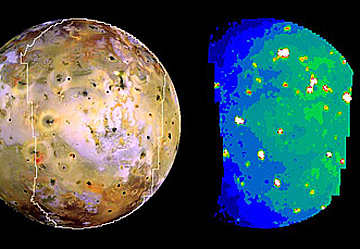The moon Io is a very remarkable moon - probably the
most fascinating body in our Solar System. It has
the most active volcanism of any body that we know.
Io is 3,630 km in diameter and is 421,600 km away
from Jupiter.
Its silicate mantle and crust are under constant
tidal flex from Jupiter and the three other Galilean
satellites. The result of this are the
constant violent eruptions of its volcanoes. It may
seem strange that Europa, Ganymede and Callisto can
provide a counterforce for Jupiter, but Ganymede and
Callisto are larger than Io. Additional "energy"
generated by Europa and Ganymede are the result of
orbital resonance which is 1:2:4 - for every
1 orbit of Europa, Io orbits twice and for every 1
orbit of Ganymede, Io orbits four times. This timing
sequence creates a resonance.

The face of Io has been describes as looking like
a pizza. All of the dots on the face are volcanoes,
and this image shows the active ones:

Close examinations by both Voyager and Galileo have
images volcanoes "caught in the act."


In addition to the volcanic activity, sulfur dust is
also introduced to the surface:

seen in the image above as the ring. In addition to
sulfur dust, lava flows are also very common:

With all of the violet eruptions constantly spewing
material upward, an atmosphere might be present -
but there isn't one. The gravity of Jupiter grabs
hold of the material and is put into orbit within
the Io Torus:

The Torus is an area of intense
electromagnetic
energy and is an area of constant study. More data
on the Io Torus can be found at the
Io Plasma Torus links.
Back to Top |

